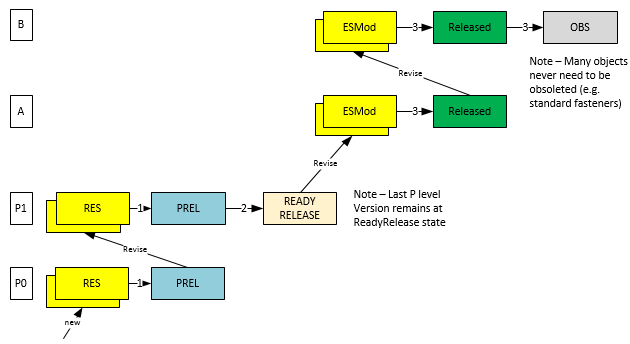Community Tip - New to the community? Learn how to post a question and get help from PTC and industry experts! X
- Community
- PLM
- Windchill Discussions
- Re: when we revise a part does the maturity increa...
- Subscribe to RSS Feed
- Mark Topic as New
- Mark Topic as Read
- Float this Topic for Current User
- Bookmark
- Subscribe
- Mute
- Printer Friendly Page
when we revise a part does the maturity increase?
- Mark as New
- Bookmark
- Subscribe
- Mute
- Subscribe to RSS Feed
- Permalink
- Notify Moderator
when we revise a part does the maturity increase?
when a part is revised does the maturity increase
- Labels:
-
Other
- Mark as New
- Bookmark
- Subscribe
- Mute
- Subscribe to RSS Feed
- Permalink
- Notify Moderator
The Revise Transition in the Lifecycle determines what the resulting State is after Revise. It's probably more of a "maturity" change than increase or advancement of maturity. Typically this is from a non-editable State (such as Released) to an editable one (such as In Work). What is and is not editable is defined in the Access Policy Administrator (Access Control List) by State as well as Principal (Role/Group/User) and Object Type. I'll qualify my response by stating that I have assumed you mean State when you refer to maturity.
- Mark as New
- Bookmark
- Subscribe
- Mute
- Subscribe to RSS Feed
- Permalink
- Notify Moderator
The diagram below and similar are throughout PTC Help and training (Windchill systems differ depending on configuration). These diagrams are correct but it may not be completely clear what is going on for Revise that makes it different from Set State or Promote.

A diagram explaining your lifecycle and transitions is critical for planning, configuring, testing, user training, etc. We came up with an enhancement to the diagram that has been very helpful to both the admin team and users. Key is to use a row for each Revision in addition to showing the states. Then, the arrows become either within a given Revision or between Revisions. The difference for Revise (and the state change which happens) becomes clear immediately.

Color coding helps. In this diagram, users can Check Out / Check In only at the yellow state and the company "does business" only at the green state. In this diagram the "stacked" yellow blocks indicate Iterations from Check Out / Check In. Color coding the states also helps in planning and explaining the different watermarks applied (Creo View) dynamically by state.
The Number 3 above relates to text elsewhere on the diagram that explains the Change process in detail. When these transitions are done using Windchill change management, Revise and Check Out / Check In are done during Change Tasks (on the Change Task object). The state change to released (3 above) is due to a Change Notice robot action. Promotion is not used here but if used, would be noted by a number on an arrow.
Note: We use a relatively complex state-based versioning two-phase lifecycle for most product data (not too different from the PTC example diagram above). This approach to the diagram helps even more for this situation, especially because Revise is the transition from numbered to lettered Revisions as well as to the next Number Revision. Here is that diagram, two variations.
MINIMUM TRANSITIONS

TYPICAL TRANSITIONS

Good luck!
- Mark as New
- Bookmark
- Subscribe
- Mute
- Subscribe to RSS Feed
- Permalink
- Notify Moderator
I look at it like this:
Revisions may or may not increase maturity. As Mike Lockwood showed in his post, the revise actually goes back a state, or decreases the maturity level.
So what real world activities do increase maturity level?
- Reviews
- Approvals
- Quotes
- Manufacturing Plans
- Prototyping
- Testing
- ETC...
The life cycle we use in Windchill need to reflect and support those real world activities of the business. (Business Requirements.)



